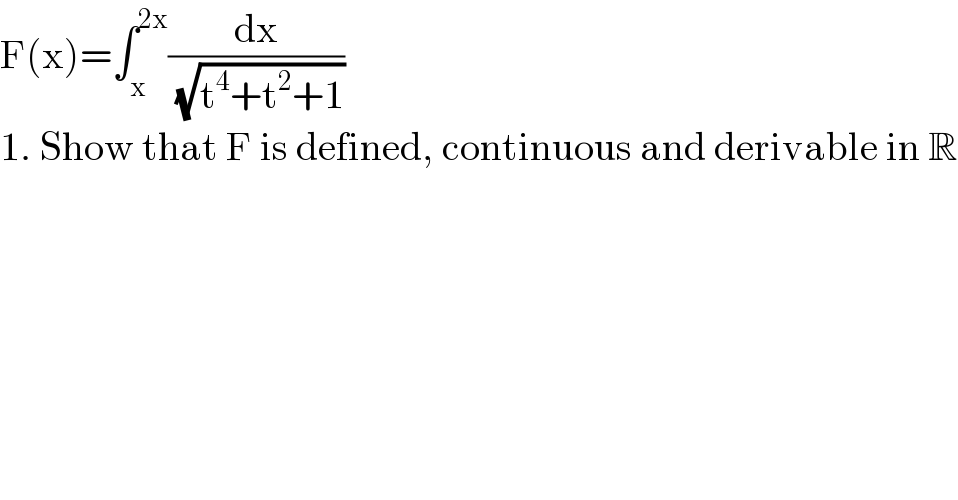Question Number 128853 by Ar Brandon last updated on 10/Jan/21

$$\mathrm{F}\left(\mathrm{x}\right)=\int_{\mathrm{x}} ^{\mathrm{2x}} \frac{\mathrm{dx}}{\:\sqrt{\mathrm{t}^{\mathrm{4}} +\mathrm{t}^{\mathrm{2}} +\mathrm{1}}} \\ $$$$\mathrm{1}.\:\mathrm{Show}\:\mathrm{that}\:\mathrm{F}\:\mathrm{is}\:\mathrm{defined},\:\mathrm{continuous}\:\mathrm{and}\:\mathrm{derivable}\:\mathrm{in}\:\mathbb{R} \\ $$
Answered by mathmax by abdo last updated on 11/Jan/21
![F(x)=∫_R (1/( (√(t^4 +t^2 +1)))) χ_([x,2x]) (t)dt the function x→((χ_([x,2x]) (t))/( (√(t^4 +t^2 +1)))) is continue and derivable so F is derivable and F^′ (x)=∫_R (∂/∂x){((χ_([x,2x]) (t))/( (√(t^4 +t^2 +1))))}dt =(2/( (√((2x)^4 +(2x)^2 +1))))−(1/( (√(x^4 +x^2 +1)))) =(2/( (√(16x^4 +4x^2 +1))))−(1/( (√(x^4 +x^2 +1))))](https://www.tinkutara.com/question/Q128881.png)
$$\mathrm{F}\left(\mathrm{x}\right)=\int_{\mathrm{R}} \:\:\frac{\mathrm{1}}{\:\sqrt{\mathrm{t}^{\mathrm{4}} \:+\mathrm{t}^{\mathrm{2}} +\mathrm{1}}}\:\chi_{\left[\mathrm{x},\mathrm{2x}\right]} \left(\mathrm{t}\right)\mathrm{dt} \\ $$$$\mathrm{the}\:\mathrm{function}\:\mathrm{x}\rightarrow\frac{\chi_{\left[\mathrm{x},\mathrm{2x}\right]} \left(\mathrm{t}\right)}{\:\sqrt{\mathrm{t}^{\mathrm{4}} \:+\mathrm{t}^{\mathrm{2}} +\mathrm{1}}}\:\mathrm{is}\:\mathrm{continue}\:\mathrm{and}\:\mathrm{derivable}\:\mathrm{so} \\ $$$$\mathrm{F}\:\mathrm{is}\:\mathrm{derivable}\:\mathrm{and}\:\mathrm{F}^{'} \left(\mathrm{x}\right)=\int_{\mathrm{R}} \:\frac{\partial}{\partial\mathrm{x}}\left\{\frac{\chi_{\left[\mathrm{x},\mathrm{2x}\right]} \left(\mathrm{t}\right)}{\:\sqrt{\mathrm{t}^{\mathrm{4}} \:+\mathrm{t}^{\mathrm{2}} \:+\mathrm{1}}}\right\}\mathrm{dt} \\ $$$$=\frac{\mathrm{2}}{\:\sqrt{\left(\mathrm{2x}\right)^{\mathrm{4}} \:+\left(\mathrm{2x}\right)^{\mathrm{2}} \:+\mathrm{1}}}−\frac{\mathrm{1}}{\:\sqrt{\mathrm{x}^{\mathrm{4}} \:+\mathrm{x}^{\mathrm{2}} \:+\mathrm{1}}}\:=\frac{\mathrm{2}}{\:\sqrt{\mathrm{16x}^{\mathrm{4}} \:+\mathrm{4x}^{\mathrm{2}} \:+\mathrm{1}}}−\frac{\mathrm{1}}{\:\sqrt{\mathrm{x}^{\mathrm{4}} \:+\mathrm{x}^{\mathrm{2}} \:+\mathrm{1}}} \\ $$
